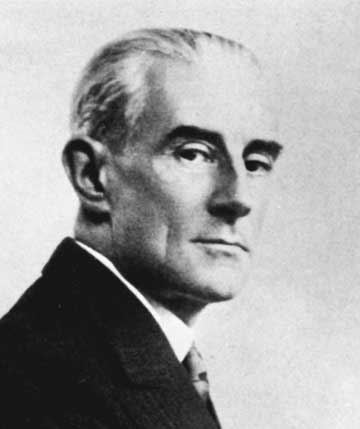Maurice Ravel (1875-1937)
Born March 7, 1875, in Ciboure, Basses-Pyrenees.
Died December 28, 1937 in Paris.
Bolero
Composition completed October 6, 1928.
First Performance: Paris Opéra on November 22 1928 with Walter Staram conducting and choreography by Bronislava Nijinska.
Ravel conducted the Lamoureux Orchestra in the first concert performance on January 11, 1930.
Instrumentation: 2 flutes, piccolo, 2 oboes, oboe d’amore, English horn, E-flat clarinet, 2 B-flat clarinets, bass clarinet, 2 bassoons, contrabassoon, 4 horns, trumpet in D, 3 trumpets in C, 3 trombones, tuba, 3 saxophones (sopranino, soprano, and tenor), 3 timpani, 2 snare drums, cymbals, tam-tam, celesta, harp, and strings.
It is hard to believe it is possible that a piece that was once called, “the most insolent monstrosity ever perpetrated in the history of music,” [4] generated more CD sales in the 1980s for orchestras than any other work. The infamous Bo Derek movie of 1979 may have had something to do with it, or even perhaps the gold medalist ice skaters from the 1984 Olympics. It is not regarded as a work of great depth, but perhaps there is something more to the music than that which appears at first glance.
Russian dancer Ida Rubinstein (1885-1960) commissioned Ravel to orchestrate Isaac Albéniz’ set of piano pieces Iberia. However, the rights belonged to another composer, and Ravel decided that it would be easier to write his own music.
A Bolero is a Spanish dance in triple meter performed by a couple who alternate between paired and solo movements. Nijinska’s choreography was set in a Spanish tavern where a dancer on a table slowly gathers the attention of the men in the bar. Gradually, one then another of the men join her while the excitement builds until violence erupts near the end.
The tempo marking at the beginning is Tempo di Bolero, moderato assai (quarter=72). That is the only tempo marking in the entire piece. Ravel was adamant that the tempo not accelerate but remain constant. Toscanini famously ignored both instructions, which led to an unpleasant confrontation between him and Ravel.
The Boléro opens with a single snare drum beating out an unchanging ostinato pattern over pizzicato strings, perhaps invoking castanets and a guitar.
Example 1

The flute enters with the first melody, which is then taken up by the clarinet while the second flute echoes the ostinato pattern.
Example 2

This is followed by a second more chromatic melody introduced by the bassoon.
Example 3

Ravel uses just these materials throughout the work. His skill as an orchestrator is shown by the interplay between the two melodies (the male and female dancers).
In a letter to fellow Les Apaches society member Michel Calvocoressi, Ravel wrote, “I am particularly desirous that there should be no misunderstanding as to my Bolero. It is an experiment in a very special and limited direction, and should not be suspected of aiming at achieving anything different from, or anything more than, it actually does achieve. Before the first performance, I issued a warning to the effect that what I had written was a piece lasting seventeen minutes and consisting wholly of orchestral tissue without music – of one long, very gradual crescendo. There are no contrasts, and there is practically no invention except in the plan and the manner of the execution. The themes are impersonal – folk tunes of the usual Spanish-Arabian kind. Whatever may have been said to the contrary, the orchestral treatment is simple and straightforward throughout, without the slightest attempt at virtuosity. In this respect, no greater contrast could be imagined than that between the Bolero and L’Enfant et les sortileges, in which I freely resort to all manners of orchestral virtuosity.”[5]
Although each work on today’s concert can be categorized as “impressionistic” we see some similarities but each composer takes a different approach. La Valse and the first movement of La Mer both emerge through a mist. The methods used to create that effect are quite different. The orchestration in each work is remarkable. Ravel adds unusual instruments such as an oboe d’amore (a timbre somewhere between an oboe and an English horn) and saxophones; even including the very rare sopranino member of that family. La Mer and The Enchanted Lake are evocative and simply suggest images of the lake or sea. In two very different works Ravel portrays specific scenarios. Finally, Mysterious Mountain was written without any preconceived images in mind.
[1] Alan Hovhaness
[2] Debussy on Music. Knopf 1977
[3] Rollo Myers. Ravel: Life and Works
[4] Edward Robinson, The American Mercury, 1932
[5] Ravel. Daily Telegraph July 11, 1931
Resources
[amazon template=iframe image&asin=0790731045][amazon template=iframe image&asin=B000I2ISKY][amazon template=iframe image&asin=B000001GLO]
[amazon template=iframe image&asin=3795765773][amazon template=iframe image&asin=B0030RXIHW][amazon template=iframe image&asin=B00EWJAZEQ]
